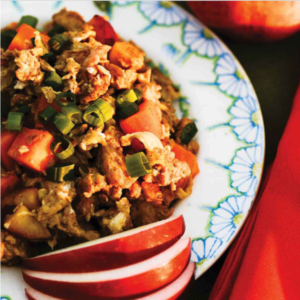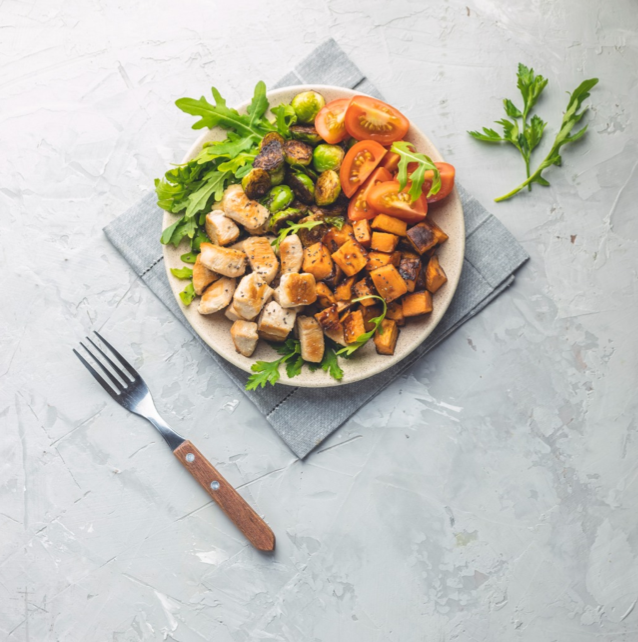Breakfast: The Most Misunderstood Meal Of The Day
25th August 2021
By Chi Feasley 
Thanks to slick advertising, breakfast is a meal that is very defined in the minds of most people. The mere mention of the word conjures up images of toast, cereal or porridge and juice which, on closer inspection, are not the best ways to start the day. Read on to find out why.
How Did We Get Here?
The rise in popularity of processed breakfast products in the standard Western diet can be traced back to two main events in history – the Agricultural Revolution and the Industrial Revolution.
For most of human history, our hunter-gatherer ancestors ate – and thrived on – an incredibly diverse, nutrient-dense diet. This changed when their descendants put down roots and began to grow a limited range of crops (mainly grains) that had long shelf lives and were convenient to transport. Living off the land in this new way, meant that carbohydrate intake soared as both protein intake and quality reached an all-time low – a tendency that persists to this day.
The Industrial Revolution, on the other hand, provided the technological means to turn wheat into flour, rice and corn into boxed cereal and whole fruits into juice. It also led to the creation of companies and ever-longer working hours for the workforce, thus creating the need for convenient – and highly processed – breakfast products.
It is important to note that the practice of processing is not necessarily unwise, providing the end result is nutritious and able to offer sustenance. This is not the case with bread, breakfast cereals and juice, to name a few, which have to be synthetically fortified in an attempt to replace lost nutrients. It is this lack of nutrient density in general (and a lack of high-quality proteins and fats in particular) that leads to mid-morning dips in energy, a yearning for true nourishment and repeated snacking as a result. Over time, this leads to a range of deficiencies, obesity and suboptimal health. Interestingly, the most nutrient-dense foods happen to be offal, shellfish and red meat, all of which are often deemed detrimental to health.
Contrary to popular belief, humans did not evolve to eat grains – including those in a whole, unprocessed form – in large quantities. In addition to their poor nutrient status, they contain substances – like phytic acid – which impair the uptake of what little nutrients they contain. Indigenous tribesmen painstakingly soaked, sprouted and fermented grains before consumption and studies now show that this ancient practice offers the best chance for nutrient absorption, however small this may be. 
The standard Western diet prioritises convenience over health and it is now clear that it is responsible for the epidemic of chronic disease that we face today. Eating in this manner is known to provoke (and sustain) an inflammatory response – an important factor in the development and progression of disease.
Characteristics Of A Nourishing Breakfast
Differing opinions on what constitutes a template for a healthy breakfast – even amongst healthcare practitioners – makes an already complex situation worse. It is, therefore, essential to keep an open mind and cultivate a desire to experiment with less commonplace alternatives than what you have become accustomed to.
In my work with clients, I recommend that breakfasts in particular – and all meals in general – should have the following characteristics:
Deeply satisfying: Animal protein is the most satisfying nutrient there is and this is why I encourage you to make it the foundational star of your breakfasts. This is especially important when you consider the long fast that precedes breakfast (for example, 13 hours if you – quite rightly – eat dinner at 6 p.m. the day before and sit down to breakfast at 7 a.m. the next morning). Having enough animal protein at breakfast sets the tone for the rest of your day by keeping you fuller for longer and regulating your blood sugar. Legumes, pulses and nuts also contain protein but it is in a form that is bound to fibre, which makes it difficult to digest and absorb. Additionally, despite widespread opinions to the contrary, legumes and pulses mainly contain carbohydrates and lack some essential amino acids. All things considered, they are not a like-for-like equivalent of animal proteins and do not provide the same benefits. While I appreciate and respect the fact that not everyone wishes to eat animal protein for various reasons (religious or otherwise), it is important to know the impact that this will have on health. In such situations, it is vital that you work with a nutritionist to help you optimise your diet as best you can.
Truly nutritious: The recommended daily allowances (RDAs) on food labels are the barest minimum required to keep a person alive. They were developed by measuring the nutrition status of the general public (most of whom are not in the best of health) and calculating the averages for each nutrient. For the average person to attain optimal health, they would need far greater amounts than the RDA and yet more if they are living with a chronic illness. It is also worth bearing in mind that sensors in the mouth and small intestine detect the presence of nutrients in the foods we eat and assess the levels of concentration of these nutrients. This valuable information is relayed to the brain which then triggers the desire to continue eating if nutritional needs are unmet, often leading – paradoxically – to simultaneous weight gain and malnutrition. The foods that I recommend are extremely nutrient-dense, thus enabling you to thrive within the context of your illness rather than merely survive.
Easily absorbed and utilised: All grains including wholegrains, popular breakfast choices (like rice, corn and oats found in boxed cereal, granola and muesli) and pseudocereals (like buckwheat found in gluten-free products) contain anti-nutrients – like phytic acid, as mentioned previously – and require soaking, fermenting and sprouting (before cooking) to make them more digestible. That said, even after taking great pains to prepare them in this way, they are still not species-appropriate foods for humans due to their poor nutrient status, inability to fuel our bodies sustainably and inflammatory nature.
Tips For Success
● Focus on what you can eat and not what you are eliminating from your diet.
● Your breakfast will be satisfying when you include enough animal protein. Aim to eat a minimum of 30g for breakfast. To put this into context, an egg contains 6g of protein and 100g of drained tinned sardines contains 24.6g.
● Let go of the Western concept of breakfast. Anything can be eaten at breakfast – including leftovers from the previous night’s dinner.
● Make small incremental changes to the intake of foods that may previously have been low. Animal protein, for example, requires sufficient stomach acid for its digestion. Long term insufficient animal protein intake results in correspondingly low stomach acid levels. Increasing your intake gradually – rather than suddenly – will give your body time to adjust to producing optimal levels of stomach acid.
What A Typical Breakfast Should Look Like
To give you an idea of proportions and portion sizes, take a dinner plate and divide it into two halves in your mind’s eye. Next, divide one of the halves into two quarters. This should give you three segments in total – one half and two quarters.
The largest segment should be filled with non-starchy vegetables in as wide an array of colours as possible. This is important because each colour represents a different nutrient and the darker the colours, the greater the concentration of nutrients.
The breakfast below is my personal favourite because it is both delicious and ticks the boxes mentioned above. Its creator, Melissa Joulwan, has very kindly permitted me to share it with you.
Recipe courtesy of Melissa Joulwan, author of the best-selling Well Fed cookbook series, including Well Fed Weeknights: Complete Paleo Meals in 45 Minutes Or Less and the blog www.MelJoulwan.com where she writes about her triumphs and failures in the kitchen, in the gym and in life.
SUNRISE SCRAMBLE
Serves 2 to 4 | Prep: 10 minutes | Cook: 10 minutes
INGREDIENTS:
1 tablespoon coconut oil or ghee 227g turkey or pork mince
1 apple, diced (about 1 cup)
2 teaspoons Sunrise Spice (see recipe below)
1 cup cooked, diced sweet potato
Salt and ground black pepper, to taste
8 large eggs, beaten
6-8 spring onions, green tops only, thinly sliced

DIRECTIONS:
Heat a large pan over medium-high heat, about 3 minutes. Add coconut oil and allow it to melt. Add the turkey and apple, stirring with a wooden spoon to break up chunks of meat. Cook until no longer pink, about 5-7 minutes. When the meat releases some of its fat, add the Sunrise Spice, sweet potato, salt and pepper. Stir to mix and cook until sweet potatoes get little brown spots.
Pour the eggs into the pan and stir to combine. Continue to scramble until desired doneness. Top with spring onions and eat immediately. Good morning!
SUNRISE SPICE
Makes 1⁄4 cup | Prep: 10 minutes | Cook: 10 minutes
INGREDIENTS:
11⁄2 tablespoons ground cinnamon
2 teaspoons ground marjoram 1 teaspoon coarse (granulated) garlic powder
1 teaspoon salt
1⁄2 teaspoon ground nutmeg 1⁄2 teaspoon paprika
1⁄2 teaspoon ground black pepper
1⁄4 teaspoon ground allspice

DIRECTIONS:
Measure all of the spices into a medium bowl and mix with a fork until combined.
Transfer the spice blend to an airtight container and sprinkle into your cooking for a sweet touch of spice to brighten your day.
Serve with vegetables prepared to your liking in as wide a variety of colours as possible.
